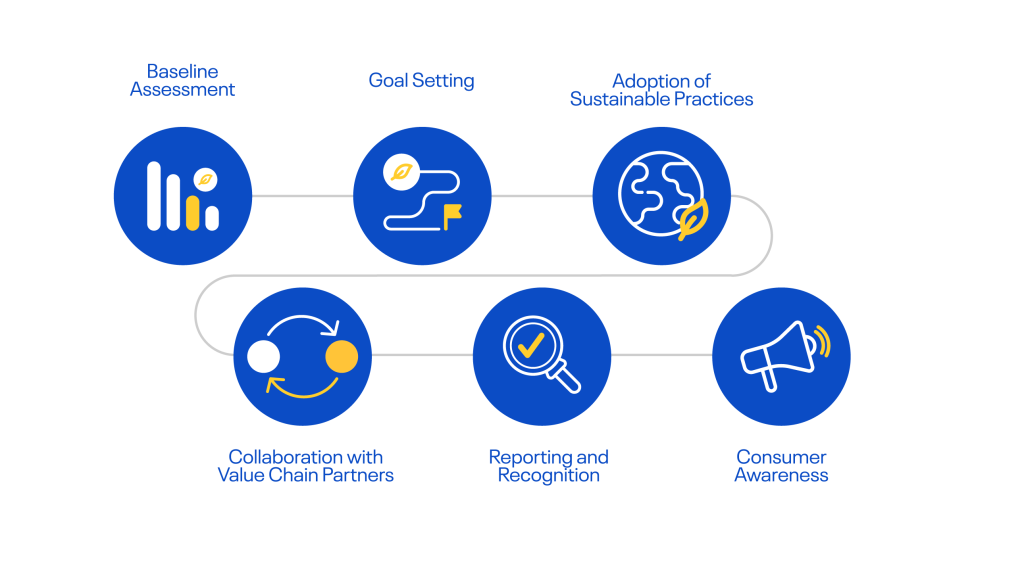
For brands, retail, and consumer goods companies on the road to net zero, it can be overwhelming to figure out how to start decarbonising their operations and value chain. Luckily, there are many tools and resources that can support companies on their journey. In this article, we explain why focusing on quantifying and mapping product carbon footprints is a good place to start.
Cop28 UN Secretary warns that “humanity’s fate hangs in the balance”.
As global leaders convened for Cop28 in Dubai on 1st December 2023, UN Secretary General António Guterres set the scene with an urgent call for action to prevent a climate catastrophe. The Paris Agreement set a goal of limiting global warming to well below 2°C, preferably to 1.5°C, compared to pre-industrial levels. Yet the latest estimates at Cop28 show that the world is on track to warm by 2.5°C by 2100 and that we are on the verge of five catastrophic climate tipping points. We are already experiencing increased climate extremes. The year 2023 has seen record breaking temperatures, unrelenting wildfires in Canada and Hawaii, and catastrophic flooding in Libya.
Companies are under growing pressure to demonstrate real and credible action on reducing their emissions, but many are behind or failing to do so. Whilst the numbers are looking up, with over half of the world’s largest companies now committed to net zero, the quality of those commitments is variable. For instance, only 37% of corporate net zero targets fully cover Scope 3 emissions, and many rely on low quality offset credits to meet their goals, rather than reducing emissions within their own operations and value chain.
Cutting Scope 3 emissions, which typically account for the large majority of a business’s carbon footprint, is a priority. For brands, retail, and consumer goods companies a significant portion of Scope 3 emissions are embedded within the products they source from value chain partners.
What are Scope 3 emissions and why do they matter?
Scope 3 refers to indirect, value chain emissions which occur at sources that a given company does not own or control. Scope 3 emissions include both the upstream and downstream value chain. Upstream includes the purchased goods and services and all the activities associated with their production. Downstream relates to the onwards footprint of a good once it is purchased by a customer.
For most companies, Scope 3 emissions account for 70% of their carbon footprint, and are 11 times higher than operational emissions. For retailers this rises to 90%. Value chain decarbonisation therefore offers one of the most significant opportunities for companies to play their part in reaching net-zero globally before 2050.
For brands, retail, and consumer goods companies, much of these emissions are tied up in retail products purchased from value chain partners. This raises several challenges. Firstly, measuring and quantifying these emissions is far more complex than it is for direct operations. Secondly, working with value chain partners to address and reduce them is time consuming and challenging.
Measuring and understanding product carbon footprints is an essential part of any credible net zero transition plan.
A high-quality net zero commitment needs to be supported by a credible transition plan. Best practice guidance for companies on preparing transition plans has recently been released by the Transition Plan Taskforce (TPT). Whilst developed in the UK, the TPT’s disclosure framework and sector specific transition guidance is highly applicable and relevant to other geographies. In essence, good transition plans must identify what needs to change (and how) in the short and medium term, for a company to reach its long-term net zero goals.
Figuring out what needs to change, starts with quantifying your current carbon footprint. For companies which have most of their carbon embedded within products, it makes sense to begin here. Calculating product carbon footprints is a complex process which involves looking at the whole value chain. Traditional methods of data collection and analysis are time consuming and expensive. Dayrize’s unique data algorithm can vastly simplify this process by accurately mapping a product’s impact through its value chain, even where data is missing. Dayrize’s tools cover Scope 1, Scope 2, and Scope 3 emissions (excluding product use and end of life).
By identifying and measuring the emissions embedded in their products, companies can take action to reduce their overall carbon footprint. A high-quality data audit of value chain emissions, allows companies to find emission hotspots in their supply chain, identify sustainability laggards and leaders, and work with suppliers to implement sustainability initiatives and build more resilient supply chains.
As Bart Nollen, Dayrize Co-Founder explains, “Net Zero is not just a destination; it’s a commitment to a sustainable future which requires robust actions, based on high quality data. At Dayrize, we believe that every step towards Net Zero is a step towards a healthier planet, a brighter future, and a more responsible way of living.”
Investor and consumer demand for sustainably produced products is increasing.
Aside from the moral and regulatory need to act on climate change, companies which include high-quality, credible transition plans in their reporting are more likely to be viewed as a good long-term investment. Investors are increasingly looking for transition plans which describe practical carbon emission reducing strategies and demonstrate how the company will remain competitive in a low-carbon business environment.
A recent survey of consumers found that 76% of people intend to shop more with retailers that offer environmentally friendly products and services. This is a trend likely to be accelerated by the increasing prevalence of climatic extremes and weather events. For instance, a recent study found that exposure to climatic extremes, in this case wildfires, increases sustainable consumption choices.
For consumers and investors, product sustainability goes beyond carbon emissions to cover a range of social and environmental factors. As well as providing accurate insights into climate change impact, Dayrize’s tool measures across 4 other dimensions – circularity, ecosystem impact, livelihoods and wellbeing, and purpose – to capture impact holistically..
Want to learn more? Subscribe to Dayrize to learn from business sustainability leaders.

